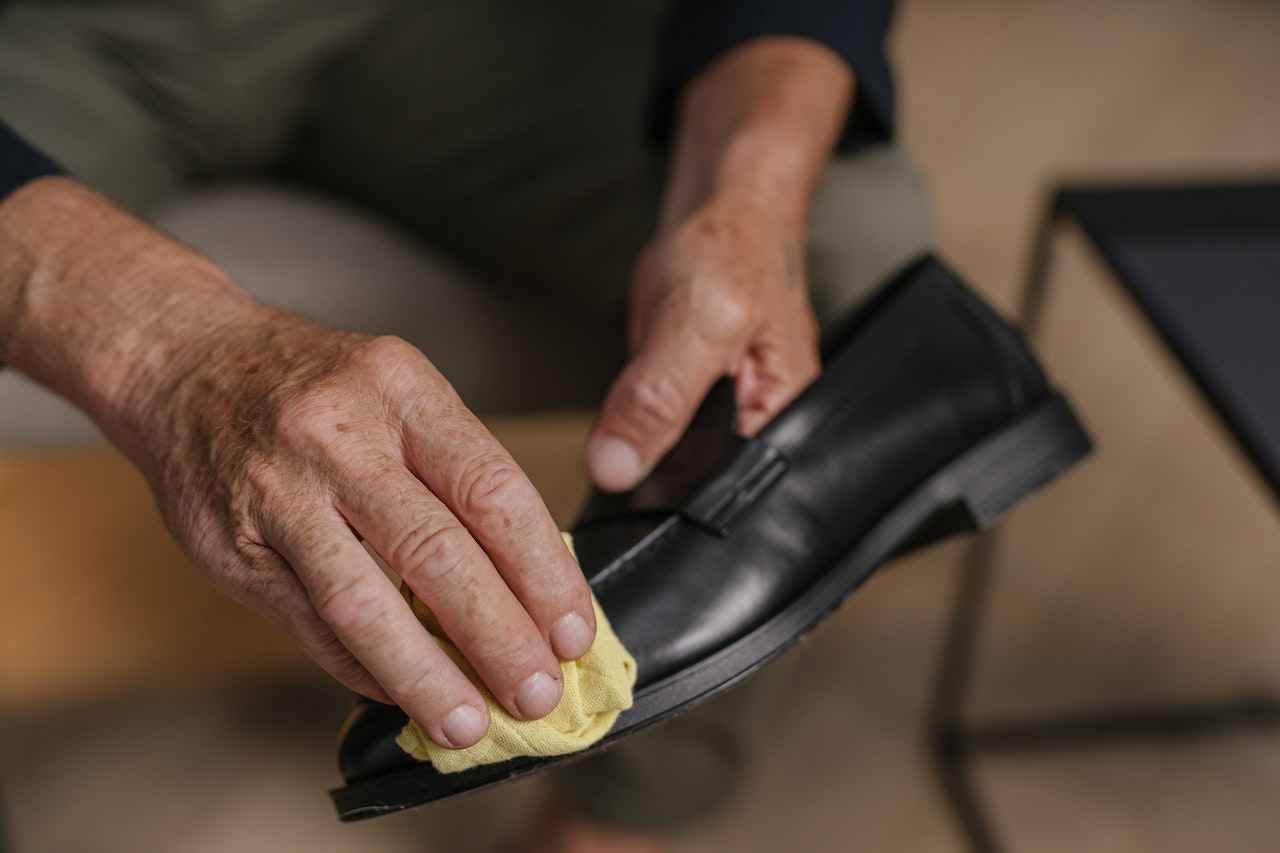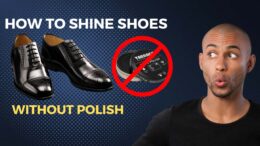To polish shoes without shoe polish, you can use alternative household items like vinegar or baking soda mixed with water. Additionally, you can use a soft cloth or a toothbrush to scrub the shoes and make them shine.
Simply follow these steps, and you will have clean and polished shoes in no time. Taking care of your shoes is essential to maintain their appearance and increase their lifespan. However, you may find yourself in a situation where you need to polish your shoes but lack shoe polish.
Fortunately, there are alternative methods to achieve a polished look without traditional shoe polish. By utilizing common household items like vinegar or baking soda mixed with water, along with a soft cloth or a toothbrush, you can effectively polish your shoes. We will explore how to polish your shoes without the need for shoe polish, providing you with simple and practical solutions.
Understanding The Importance Of Shoe Maintenance
Maintaining the quality and appearance of your shoes is essential if you want them to last. Neglecting proper shoe care can result in worn-out, scuffed, and damaged footwear, which not only looks unsightly but also reduces the longevity of your shoes.
In this section, we will explore why polishing shoes is important for their longevity and the benefits of regular shoe maintenance.
Why Polishing Shoes Is Important For Their Longevity:
- Enhances durability: Regularly polishing your shoes helps to maintain the integrity of the leather by preventing cracks and drying out. This extends the lifespan of your shoes and saves you money in the long run.
- Protects against scuffs and stains: Polishing creates a protective barrier on the shoe’s surface, shielding it from scuffs, watermarks, and stains. This is particularly crucial for leather shoes, as the polish acts as a guard against harsh elements.
- Restores shine and color: Over time, shoes can lose their luster and color due to normal wear and tear. Polishing revives the shine and enhances the color, making your shoes look like new again.
- Improves overall appearance: Well-maintained shoes create a positive impression and enhance your overall appearance. Whether for work or social occasions, polished shoes reflect your attention to detail and professionalism.

The Benefits Of Regular Shoe Maintenance:
- Prolongs shoe life: By regularly cleaning and polishing your shoes, you can significantly extend their lifespan. Proper maintenance prevents premature wear and tear and keeps your shoes looking presentable for longer periods.
- Prevents bad odor: Funky odors can develop in shoes due to bacteria and accumulated sweat. Regular cleaning and deodorizing treatments keep unpleasant smells at bay, ensuring your shoes remain fresh and odor-free.
- Increases comfort: Shoes that are well-maintained provide better comfort and support. Cleaning removes accumulated dirt and debris, while conditioning treatments prevent leather from drying and cracking, ensuring optimal comfort with each wear.
- Saves money: Investing a little time in shoe maintenance can save you money in the long term. By caring for your shoes regularly, you reduce the need for costly repairs or replacements, thereby maximizing your footwear investment.
Remember, incorporating shoe maintenance into your routine is not only beneficial for your shoes’ longevity but also contributes to your overall style and confidence. By following these simple practices, you can keep your shoes in top shape, ready to make a great impression wherever you go.
Exploring Alternative Methods For Polishing Shoes
Homemade Shoe Polish Recipes
Maintaining the shine and longevity of your shoes doesn’t always require expensive shoe polish. In fact, you can polish your shoes using everyday items found around your home. Here are some homemade shoe polish recipes that you can easily whip up:
- Olive oil: Apply a small amount of olive oil to a soft cloth and rub it onto your shoes using gentle circular motions. This will moisturize the leather and bring back its shine.
- Banana peel: The potassium and natural oils in banana peels make them an excellent alternative for shoe polishing. Rub the inside of a ripe banana peel on your shoes and buff with a clean cloth.
- Vinegar: Mix equal parts vinegar and water, then dampen a cloth with the solution. Gently rub it onto your shoes to remove dirt and stains, and restore their natural luster.
Using Household Items To Polish Shoes
Sometimes, the best way to polish your shoes is by utilizing ordinary items you already have at home. These household hacks will help you keep your shoes looking their best:
- Toothpaste: Apply a small amount of non-gel toothpaste to a toothbrush, then scrub your shoes in small circular motions. Wipe off the toothpaste with a damp cloth and let your shoes dry. The mild abrasives in toothpaste can remove scuffs and polish the surface.
- Nail polish remover: If your shoes have stubborn stains or marks, dipping a cotton ball or cloth in nail polish remover can help eliminate them. Remember to test it on a small inconspicuous area first to ensure it doesn’t damage the material.
- Hairdryer: Use a hairdryer on a low heat setting to warm the leather. Then, apply a leather conditioner or moisturizer to revive dull shoes and give them a fresh shine.
Natural Alternatives To Commercial Shoe Polish
If you prefer to use natural products instead of commercial shoe polish, there are plenty of options available. These natural alternatives will help you achieve a polished look without any harsh chemicals:
- Beeswax: Melt a small amount of beeswax and mix it with a carrier oil, such as olive or coconut oil. Apply the mixture to your shoes using a soft cloth and let it dry. The beeswax will provide a protective barrier and restore the shine.
- Lemon juice: Lemon juice is an excellent natural cleaner and brightener. Squeeze some lemon juice onto a cloth and rub it onto your shoes. The acidity of the lemon will help remove stains and leave your shoes looking glossy.
- Petroleum jelly: Apply a thin layer of petroleum jelly to your shoes and let it sit for a few minutes. Wipe off the excess with a clean cloth, and your shoes will have a renewed shine.
With these homemade shoe polish recipes and household items, you can easily maintain the appearance of your shoes without the need for traditional shoe polish. Not only will you save money, but you’ll also discover the power of everyday items in revitalizing your footwear.
Step-By-Step Guide
Cleaning and preparing the shoes:
- Start by wiping the shoes with a clean, damp cloth to remove any dirt or dust.
- Use a mild soap or dish detergent mixed with water to scrub away stubborn stains or dirt marks. Be gentle while scrubbing to avoid damaging the leather.
- Rinse the shoes with clean water and pat them dry with a soft towel.
- For scuff marks or extra stubborn stains, try using a pencil eraser or a small amount of toothpaste on a soft cloth to gently rub the marks away.
Conditioning the leather:
- Apply a small amount of leather conditioner or lotion onto a soft cloth.
- Rub the conditioner onto the shoes in circular motions, covering the entire surface. Make sure to pay extra attention to any cracked or dry areas.
- Allow the conditioner to penetrate the leather for a few minutes.
- Wipe off any excess conditioner with a clean cloth.
Buffing and shining the shoes:
- To give your shoes a high shine, use a clean, dry cloth and buff the leather in small, circular motions.
- Apply a small amount of baby oil or olive oil onto a soft cloth.
- Rub the oil onto the shoes, focusing on one section at a time. This will help bring out the shine and make the leather look more polished.
- Once the oil has been applied, buff the shoes once again with a clean, dry cloth to remove any excess oil and bring out the shine.
With these simple and effective steps, you can easily polish your shoes without the need for shoe polish. Remember to regularly clean and condition your shoes to keep them looking their best and to prolong their lifespan. So why wait, give your shoes the tlc they deserve and enjoy a polished and stylish look without shoe polish!
Tips And Tricks For Effective Shoe Polishing
Keeping your shoes looking clean and polished can greatly enhance your overall appearance. However, what do you do when you want to polish your shoes but don’t have any shoe polish on hand? Don’t worry! We have some handy tips and tricks for you to achieve a polished look without using traditional shoe polish.
Don’T Forget To Clean The Soles And Edges
When it comes to polishing shoes, many people tend to focus solely on the upper surface. However, neglecting the soles and edges can result in a less-than-perfect finish. Here are some key points to keep in mind when cleaning the soles and edges:
- Start by removing any dirt or debris from the soles using a brush or a damp cloth.
- Use a toothbrush or small brush to scrub the edges of the shoes, removing any scuff marks or dirt.
- For stubborn stains on the soles, you can use a mix of baking soda and water to create a paste. Apply the paste to the stains, let it sit for a few minutes, then scrub with a brush.
Choosing The Right Cloth Or Brush For Each Step
The type of cloth or brush you use can make a significant difference in the outcome of your shoe polishing. Consider these points when selecting the right tool for each step:
- For removing dirt and debris, use a soft-bristled brush or a clean cloth.
- When applying polish or an alternative method, opt for a soft cloth or a shoe dauber to ensure even application.
- For buffing and shining, a soft buffing cloth or an old t-shirt works wonders.
Applying The Polish Or Alternative Method Evenly
Once you have cleaned the soles and edges and have chosen the right cloth or brush, it’s time to apply the polish or alternative method. To ensure an even and consistent outcome, follow these steps:
- Apply a small amount of polish or alternative substance (such as olive oil or petroleum jelly) onto the cloth or shoe dauber.
- Start applying the polish in small circular motions, working your way from the toe to the heel, ensuring every inch of the shoe is covered.
- Pay attention to any creases or lines on the shoes, as they can easily collect excess polish.
- Allow the polish to dry for a few minutes before buffing with a clean cloth or brush to achieve a glossy shine.
Remember, while these tips and tricks can help you achieve a polished look without shoe polish, it’s always a good idea to invest in a proper shoe care kit for the best long-term results. Happy shoe polishing!
How To Care For Different Types Of Shoes
Leather Shoes
Taking care of your leather shoes doesn’t always require shoe polish. There are several alternative methods you can use to keep them looking their best. Here are some key points to remember:
- Wipe down your shoes regularly with a damp cloth to remove any dirt or dust.
- Use a leather conditioner to moisturize and protect the leather from drying out or cracking.
- Buff the shoes with a soft cloth or brush to restore their shine.
- If your leather shoes have stains, use a mild soap and water solution to gently clean the affected area.
- Allow your shoes to dry naturally after cleaning or conditioning, avoiding direct heat sources.
Suede Or Nubuck Shoes
Caring for suede or nubuck shoes requires a slightly different approach as they are more delicate materials. Here are some tips to keep in mind:
- Use a suede brush or eraser to remove any surface dirt or scuff marks from your shoes.
- For more stubborn stains, try using a suede cleaner specifically designed for these materials.
- To refresh the appearance of your suede shoes, use a suede spray or conditioner to restore their color and texture.
- Be cautious with water as it can cause staining or damage to suede, so avoid wearing your suede shoes in rainy or wet conditions.
- Store suede shoes in a breathable bag or box to prevent dust accumulation and maintain their shape.
Canvas Or Fabric Shoes
Canvas or fabric shoes can also be polished and cared for without traditional shoe polish. Follow these steps to keep them looking clean and fresh:
- Start by brushing off any loose dirt or debris from the surface of your shoes using a soft brush or cloth.
- To remove stains, create a mixture of mild detergent and warm water and gently scrub the affected areas.
- Allow your canvas shoes to air dry naturally, avoiding excessive heat which can cause shrinkage or damage.
- For white canvas shoes, you can use a baking soda paste or whitening toothpaste to brighten them up.
- Lastly, to protect your fabric shoes from stains and spills, consider applying a fabric protector spray.
Remember, even without shoe polish, you can still maintain the appearance and longevity of your leather, suede, or fabric shoes with proper care and maintenance.

Credit: www.reddit.com
Maintaining The Polished Look For a Longer
After learning how to polish your shoes without shoe polish, the next step is to ensure that the polished look lasts as long as possible. Proper storage of shoes, a regular cleaning and maintenance routine, and avoiding common mistakes are key to maintaining that polished appearance.
Let’s explore each of these aspects in detail:
Proper Storage Of Shoes
To keep your polished shoes in top condition, follow these storage tips:
- Clean the shoes before storing them to remove any dirt or debris that can dull the shine.
- Place shoe trees or crumpled newspaper inside the shoes to help them retain their shape.
- Store your shoes in a cool, dry place, away from direct sunlight, as heat and moisture can damage the finish.
- Consider using shoe bags or boxes to protect them from dust and scratches.
Regular Cleaning And Maintenance Routine
A consistent cleaning and maintenance routine is essential for prolonging the polished look of your shoes. Here’s what you should do:
- Wipe your shoes with a damp cloth after each wear to remove surface dirt and prevent it from settling into the leather.
- Use a soft brush or cloth to apply a small amount of mild soap solution to clean the shoes thoroughly.
- Rinse off the soap with a clean damp cloth and pat dry.
- Apply a leather conditioner or cream to keep the leather supple and prevent it from drying out or cracking.
- Use a polishing brush or cloth to buff the shoes gently to restore their shine.
- Repeat this routine regularly, depending on the frequency of use and the condition of the shoes.
Avoiding Common Mistakes That Ruin The Polish
To ensure the polish remains intact, avoid these common mistakes:
- Avoid using excessive water or harsh cleaning agents, as they can damage the leather and strip away the polish.
- Never dry your shoes near a heat source, as it can cause the leather to crack and the polish to fade.
- Do not store your shoes in plastic bags, as they can trap moisture and cause mold growth.
- Avoid wearing the same pair of shoes every day, as it can lead to excessive wear and tear, diminishing the polished look.
- Be mindful of where you walk to prevent scuffing or scratching your shoes.
By following these guidelines and incorporating them into your shoe care routine, you can maintain the polished look of your shoes without relying on shoe polish. Proper storage, regular cleaning, and avoidance of common mistakes are key to keeping your shoes looking their best for longer.
Frequently Asked Questions For How To Polish Shoes Without Shoe Polish
How Can I Polish My Shoes Without Shoe Polish?
You can polish your shoes without shoe polish by using alternative methods such as using olive oil, banana peel, or toothpaste. These household items can help restore shine and remove scuffs from your shoes.
Is It Safe To Use Olive Oil On Shoes?
Yes, it is safe to use olive oil on shoes. Olive oil can provide a natural shine and nourish leather, making it a great alternative to shoe polish. Apply a small amount of olive oil to a cloth and gently rub it into the leather to restore its shine.
Can Toothpaste Clean And Polish Shoes?
Toothpaste can be used to clean and polish shoes, especially white sneakers. Apply a small amount of toothpaste to a toothbrush or cloth, then gently scrub the shoes. Rinse off the toothpaste with water and your shoes will have a fresh shine.
What Other Household Items Can I Use To Polish My Shoes?
Apart from shoe polish, you can use household items such as a banana peel, baking soda, or vinegar to polish your shoes. Rub the inside of a banana peel on your shoes, or create a paste using baking soda and water.
Vinegar can also be used to remove stains and polish leather shoes.
Can I Use A Cloth To Polish My Shoes?
Yes, using a clean cloth to polish your shoes is an effective method. Whether you’re using shoe polish or alternative methods, a cloth can help distribute the product evenly and buff the shoes to a shine. Ensure the cloth is clean and free of any debris to avoid scratching the shoes.
Conclusion
It is possible to achieve shiny, polished shoes without shoe polish by utilizing household items and simple techniques. The methods discussed offer practical and cost-effective solutions to keep your shoes looking their best. Remember to start by thoroughly cleaning the shoes and removing any dirt or grime.
From there, you can explore options like vinegar, baking soda, or even a banana peel to restore shine. Rubbing the shoes with a soft cloth or brushing them with a toothbrush will help bring out their natural luster.
By employing these alternative methods, you can save money and reduce your reliance on commercial shoe polish. So, give these techniques a try and keep your shoes looking sharp without the need for shoe polish. Your shoes will thank you!


